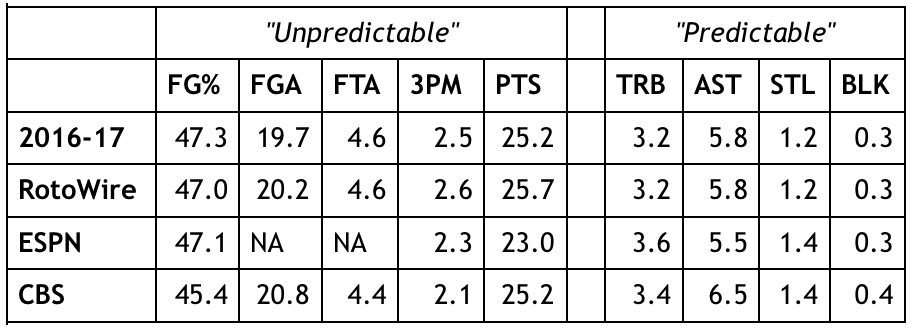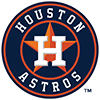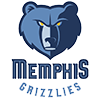For years, the NBA offseason has been one of the wildest rides in American sports. Nonetheless, 2017 raised the bar for summer insanity. Free agency was predictably unpredictable, but the trades are what really went off the rails. Four legitimate superstars were traded, with widely disparate returns. The Bulls traded Jimmy Butler for a draft pick and a pack of bubble gum, and before they'd finished chewing, the Celtics gave up their franchise player, a quality starter and a better draft pick for Kyrie Irving. By the time the dust settled, more than a dozen All-Stars had changed teams.
This hyperactive offseason presents a challenge heading into the 2017-18 season. How do we anticipate the production from the (banana-) boatloads of impact players in new situations?
After 2017's active trade deadline, I researched the age old question: are they "who we thought they were"? How much of a player's production is dependent on his own abilities, and how much of it is the result of his situation? With so many impact players on the move, this question is more important now than ever.
Every fantasy site has released their projections, including for the scores of players in new settings. What we need to know is how much of those projections are reliable, and how much are glorified guesswork? After solving that, the question shifts to how we can use this knowledge to our advantage in fantasy.
What do we already know?
That trade deadline article focused
For years, the NBA offseason has been one of the wildest rides in American sports. Nonetheless, 2017 raised the bar for summer insanity. Free agency was predictably unpredictable, but the trades are what really went off the rails. Four legitimate superstars were traded, with widely disparate returns. The Bulls traded Jimmy Butler for a draft pick and a pack of bubble gum, and before they'd finished chewing, the Celtics gave up their franchise player, a quality starter and a better draft pick for Kyrie Irving. By the time the dust settled, more than a dozen All-Stars had changed teams.
This hyperactive offseason presents a challenge heading into the 2017-18 season. How do we anticipate the production from the (banana-) boatloads of impact players in new situations?
After 2017's active trade deadline, I researched the age old question: are they "who we thought they were"? How much of a player's production is dependent on his own abilities, and how much of it is the result of his situation? With so many impact players on the move, this question is more important now than ever.
Every fantasy site has released their projections, including for the scores of players in new settings. What we need to know is how much of those projections are reliable, and how much are glorified guesswork? After solving that, the question shifts to how we can use this knowledge to our advantage in fantasy.
What do we already know?
That trade deadline article focused on per-possession production. In it I found that some categories stayed basically constant when someone changed teams, while other categories varied dramatically:
• Rebounds are highly consistent regardless of team setting; this is especially true of offensive rebounds; the more minutes someone plays, the more predictive his rebounding numbers.
• Assists are the most consistent regardless of team setting; players with high assists are also more predictable across the board than low volume assisters.
• Steals are very consistent among high volume thieves (>1.5 per 100 possessions), somewhat consistent among medium volume thieves (between 0.7 and 1.5 per 100 possessions) and totally inconsistent among low volume thieves.
• Blocks are the inverse of steals – players who rarely block shots continue to rarely block shots, but high volume shot blockers are heavily impacted by a change in situation.
• Points, FGA and FG% are highly inconsistent from one team to the next. The predictive value of stats from the previous team in these categories is close to zero.
• Three-point attempts have some predictive value from one team to the next. Three-pointers made, however, do not.
One-sentence summary: Predictions for non-scoring categories should be heavily based on past production, while predictions for scoring related categories are closer to glorified guesswork.
It's important to acknowledge that, while scoring-related projections are based on a less mathematically legitimate foundation, they still have an important place. Even if we know that these projections are likely flawed, it's helpful to have a starting place to adjust off of. And while scoring-related projections shouldn't be spit out of an algorithm, there are still very smart basketball minds making educated and informed decisions about what expectations are reasonable.
A Case Study
Let's use Kyrie Irving, who was traded from the Cavaliers to the Celtics, as an example of how to put these findings to use. Irving is replacing Isaiah Thomas, and since both players averaged similar minutes and possessions per game last season, we can assume that Irving's new workload will be similar to his old one.
This chart shows Irving's 2016-17 per game averages in the relatively predictable categories. The squares are color-coordinated to demonstrate how much confidence each should inspire. Since high-volume passers are the most predictable, Irving's high assist total is green. Meanwhile, his low offensive rebounds are red, since they indicate increased variability in a player's overall rebounds.

Now let's look at Irving's projections. Field-goal percentage, field-goal attempts, free-throw attempts, three-pointers made and points have been added in – though these numbers are less reliable, they have a large impact on a player's value, and therefore warrant attention. The more predictable stats have been bracketed off for easier viewing.

With the exception of CBS' assists projection, it looks like everybody got the memo that there shouldn't be a ton of changes in the "predictable categories." However, all three projections also assumed minimal volatility in the scoring categories. When players change teams, those categories typically change, and their changes are not all that predictable – they can swing wildly in either direction. All three sites took the safe route and predicted minimal change. By predicting minimal changes, they have minimized their potential error and effectively accepted that the projections won't be perfect.
Irving's fantasy value is based primarily on four categories – points, threes, free throws, and assists. Since three of those four are "unpredictable," his overall value is very uncertain. In eight-category settings, RotoWire projects him at 17th and ESPN has him at 15th. CBS doesn't offer overall projections, but Irving is pre-ranked 11th inside their mock drafts.
Now that we've built our baseline understanding, let's get to how we use it. My recommendation depends on two factors – your personal risk preference, and your personal expectations for Irving.
• Managers who prefer to minimize risk early should avoid Irving, in case each site over-estimated his production in points, threes, and free throws. Each site ranked him very high overall, especially for someone who gets most of his value from hard-to-anticipate categories.
• Managers who think Irving's scoring-related category projections are low should target him, though they will have to grab him early.
Personally, I think that each site is underestimating his points and threes numbers, which is why I am targeting him very early in the second round.
Widening our net
If I broke down every player in that much detail, this article would take forever, and you'd probably stop reading. So instead let's transition to a more rapid-fire approach. In a smoky backroom somewhere (or in my home office in Delaware) I'm going through that same thought process that I went through with Irving, but you get to fast-forward to the part where I make my conclusion.
Players are listed in the order that I would draft them in an eight-category league. A few players listed, such as Kristaps Porzingis and Myles Turner, did not change teams, but are included because their teams underwent significant offseason changes. CBS's projections will not be mentioned due to difficulties with their user interface.
Chris Paul, Rockets (formerly Clippers)
Workload: The Rockets play much faster than the Clippers, and Paul was already under 32 minutes per game last season, so he'll likely see a slight increase in possessions.
Predictability: Paul is elite in assists and steals, two of the most predictably consistent categories. He's also very good in points, threes, and free throws, but that's considerably less important to his value than it is for four of the next five players on this list.
Projections: ESPN ranks him a comically low 28th, but their categorical projections are reasonable and would imply a higher pick. RotoWire's 11th ranking makes sense, and even that is based on a bigger drop-off than I think is warranted. RotoWire is predicting a larger drop in assists than this research would anticipate.
Recommendation: Age and injuries should be much bigger concerns than his new team. Paul can be drafted with confidence around the turn.
Jimmy Butler, Timberwolves (formerly Bulls)
Workload: The Bulls and Timberwolves played at nearly identical paces, and given Tom Thibodeau's tendencies, Butler's minutes are unlikely to change. His workload will probably be remarkably similar to last season's.
Predictability: Butler is elite in steals and free throws, and very good in points and assists. His key contributions, therefore, are split between the 'predictable' and the "unpredictable" categories.
Projections: RotoWire is predicting a big drop in assists, while ESPN is projecting the same assists drop in addition to a decrease in rebounds. Those drops are too large, according to this research. Both sites are aligned in projecting less overall impact in the scoring-related categors, with the biggest difference between the two being that RotoWire projects more points and a lower field goal percentage, a logical tradeoff. He's ranked 19th and 25th, respectively.
Recommendation: Butler is a high usage player who gets important value from volatile categories, so there is some risk imbued in his new surroundings, especially as he joins a team replete with other high usage players. Both ESPN and RotoWire are predicting a larger offensive decline than I think is likely, but disagreements are inevitable when projecting volatile categories. However, both are underrating his passing. Depending on your expectations regarding his scoring-related production, he could make sense at any point in the second or early third round.
Kristaps Porzingis, Knicks (departures of Carmelo Anthony and Derrick Rose)
Workload: Porzingis will probably see a very similar amount of court time and possessions, though his usage rate will likely increase.
Predictability: Porzingis is a fairly balanced producer, but by far his biggest source of value is his blocks. High volume rim protectors are not particularly predictable, so his value there could change dramatically. The acquisition of Enes Kanter, a dreadful defender both in the paint and along the perimeter, could either help or hurt Porzingis' block totals, depending on the defensive scheme. His next best categories are points, threes, and rebounds, two of which are "unpredictable."
Projections: Both sites anticipate big boosts in scoring, and modest rebound growth, though ESPN projects a decline in threes. RotoWire ranks him 20th, and ESPN ranks him 24th.
Recommendation: Pretty much everyone expects an offensive improvement with Anthony and Rose now gone, but the amount of improvement is nearly impossible to foresee. His rankings seem reasonable, but with so much value in hard-to-predict categories, his final standing could look very different from his Average Draft Position (ADP). Managers should not assume that he will repeat his 2.0 blocks per game. Like Irving, your approach to Porzingis should be based on your own risk tolerance and your personal expectations for him.
Kyrie Irving, Celtics (formerly Cavaliers)
See above.
Paul George, Thunder (formerly Pacers)
Workload: The Thunder play faster than the Pacers, so assuming George sees a slight decline in minutes, he'll likely be on the floor for a very similar number of possessions.
Predictability: George is just barely sub-elite in points, threes, steals, and free throws. He also adds a little value in rebounds and assists, but those contributions are comparably minor. The overwhelming majority of his value comes from unpredictable categories.
Projections: Both sites predict minimal changes from last year, except while RotoWire projects slight across-the-board declines, ESPN projects slight improvements. RotoWire has him at 16th, and ESPN at 6th.
Recommendation: The difference in the two sites' approached perfectly exemplifies the potential risk and reward here. As he gets most of his value from unpredictable categories, he has a wide range of possible outcomes, similar to Porzingis and Irving.
Gordon Hayward, Celtics (formerly Jazz)
Workload: Hayward will almost certainly see more possessions after leaving the slowest team in the league and joining an above-average paced team.
Predictability: Hayward's best categories are points, threes, and free throws, all unpredictable stats, but those are less important to him than to most of the players above. Hayward is solid in rebounds, assists and steals and loses value in blocks, all of which is mostly replicable. He should be considered more predictable than everyone listed above, with only the possible exception of Chris Paul.
Projections: Both sites are projecting a step back offensively, with relatively small improvements in some of the counting stats. Given the extra possessions that should be expected playing for a faster team, those counting stats projects seem conservative. ESPN has Hayward at 18, and RotoWire has him at 36.
Recommendation: Hayward has two things in his favor above most of the players here listed – his value is less dependent on the more volatile categories, and he's likely to play more possessions. In my rankings he's closer to 18 than 36.
Myles Turner, Pacers (departures of Paul George, Jeff Teague)
Workload: Turner will probably see more minutes, and thus, more possessions.
Predictability: Turner gets most of his value from blocks, rebounds, and field goal percentage. He's likely to continue getting large quantities of blocks and rebounds, but high-volume shot-blocking is volatile when a roster shifts as much as the Pacers' did this offseason.
Projections: Though both sites project nearly identical production, ESPN ranks Turner 45th, while RotoWire has him at 32.
Recommendation: Given his age, increased role, and increased possessions, combined with his value coming from relatively predictable areas, I'm comfortable taking Turner ahead of both sites' rankings.
DeAndre Jordan, Clippers (departure of Chris Paul)
Workload: Jordan might see a small increase in minutes, but otherwise his workload is unlikely to change much.
Predictability: Jordan gets almost all of his value from his field goal percentage, rebounding, and blocks. Given the nature of his offensive game, his field goal percentage should be considered less unpredictable than would normally be assumed. His rebounds are highly predictable, and since he didn't actually change teams or defensive schemes and the frontcourt depth chart was stable, his shot-blocking is unlikely to change much.
Projections: Both sites have very similar categorical projections, and both rank him in the mid-60s.
Recommendation: The loss of Paul is not likely to have a dramatic impact on Jordan's value.
Brook Lopez, Lakers (formerly Nets)
Workload: Lopez is moving to a slower team, but he's also likely to see more minutes after averaging less than 30 in 2016-17. He's likely to see a very similar number of possessions in his new home.
Predictability: Very poor. Almost all of Lopez's value comes from points, threes, field goals and free throws, and high-volume blocks. None of those are highly predictable categories.
Projections: RotoWire has him at 26th, while ESPN has him at 45th.
Recommendation: Lopez should be handled the same way as Porzingis, Irving, and George. Since his value is in volatile categories, draft him according to your own expectations, as well as your own appetite for risk.




























